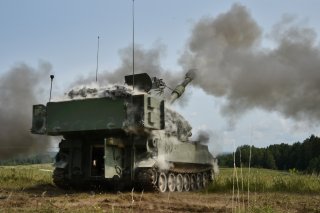How the US Army Can Kill You more than 30 Kilometers away
The PIM program is necessary to address capability gaps for self-propelled artillery, Army developers explained.
Here's What You Need to Remember: With this kind of scenario in mind, the U.S. Army and Raytheon are working on a newly configured tank-killing “Shaped Charge” 155m precision-guided artillery round as part of a large-scale strategic attempt to outrange enemies and destroy approaching enemy armored columns at safer standoff ranges.
For decades, mobile and Self-Propelled Army 155mm artillery cannons maxed out ranges at about 30-to-40km, until now.
In recent years the Army has massively extended the range at which its GPS-guided precision rounds can attack, by architecting a first-of-its-kind Extended Range Cannon Artillery program
Due to its continued role providing the technical foundation for the Army’s new breakthrough 70km Extended Range Cannon Artillery program, the Army’s 155mm Paladin Integrated Management (PIM) howitzer is being maintained and upgraded for future war.
The Army’s ERCA weapons system combines a Paladin PIM’s chassis, ammunition, and fire control components with a longer 58-caliber cannon. The new range-doubling weapon, which is showing great promise, amounts to an adaptation of the existing PIM vehicle. The PIM can fire precision rounds, accommodate additional armor protections, and power up more onboard electrical systems. The vehicle features a 600-volt on-board power system designed to accommodate emerging networking technologies as they become available. Interestingly, some of the technical foundations and modernization efforts fundamental to maintaining and preparing the Paladin go back many years, as seen in this previous publicly released Army report posted on their website from several years ago.
The PIM’s onboard power system harnesses technologies developed for the Non-Line-of-Sight Cannon (NLOS-C), a 155mm howitzer formerly developed for the Future Combat Systems’ Manned Ground Vehicles program, which was canceled in 2009. The electric drives from the NLOS-C are faster than the hydraulic drives used by previous self-propelled howitzers. An Army weapons developer explained to The National Interest that the electric drives create a more consistent ramming of the round which then generates more consistent muzzle velocities. The electric drives also generate much greater levels of on board power necessary for advanced electronics, sensors, and command and control systems.
The PIM vehicle’s cannon rests on a chassis built with Bradley Fighting Vehicle common components, including engine, transmission, and tracks. The PIM includes a sustained rate of fire of one round per minute and a maximum rate of fire of four rounds per minute. The Army has in recent years been building hundreds of new Paladin PIM sets, each including a self-propelled howitzer and an ammunition resupply vehicle.
The existing fleet of M109A6 Howitzers, originally designed in the 1950s and produced in the 1960s, is nearing obsolescence. The current fleet exceeds its weight and power capacity and does not provide for growth in mobility and force protection. The PIM program is necessary to address capability gaps for self-propelled artillery, Army developers explained.
The longer-range cannon is also being supported by commensurate lethality upgrades such as the emergence of new rounds able to attack and destroy a wider sphere of targets. With this kind of scenario in mind, the U.S. Army and Raytheon are working on a newly configured tank-killing “Shaped Charge” 155m precision-guided artillery round as part of a large-scale strategic attempt to outrange enemies and destroy approaching enemy armored columns at safer standoff ranges.
The new weapon represents an exponential leap beyond existing state-of-the-art anti-tank weapons such as the TOW and Javelin missiles; the Javelin reaches ranges up to 2.5miles and the TOW missile can hit targets out to 3,000meters. The Excalibur “shaped charge” brings an entirely new anti-tank weapon, able to reach as far as 30km. Senior Army weapons developers explain that extending ground-war attack ranges changes some of the traditional elements of Combined Arms Maneuver strategy.
Kris Osborn is the defense editor for the National Interest. Osborn previously served at the Pentagon as a Highly Qualified Expert with the Office of the Assistant Secretary of the Army—Acquisition, Logistics & Technology. Osborn has also worked as an anchor and on-air military specialist at national TV networks. He has appeared as a guest military expert on Fox News, MSNBC, The Military Channel, and The History Channel. He also has a Master's Degree in Comparative Literature from Columbia University.
This article first appeared earlier this year and is being reprinted for reader interest.
Image: Flickr

